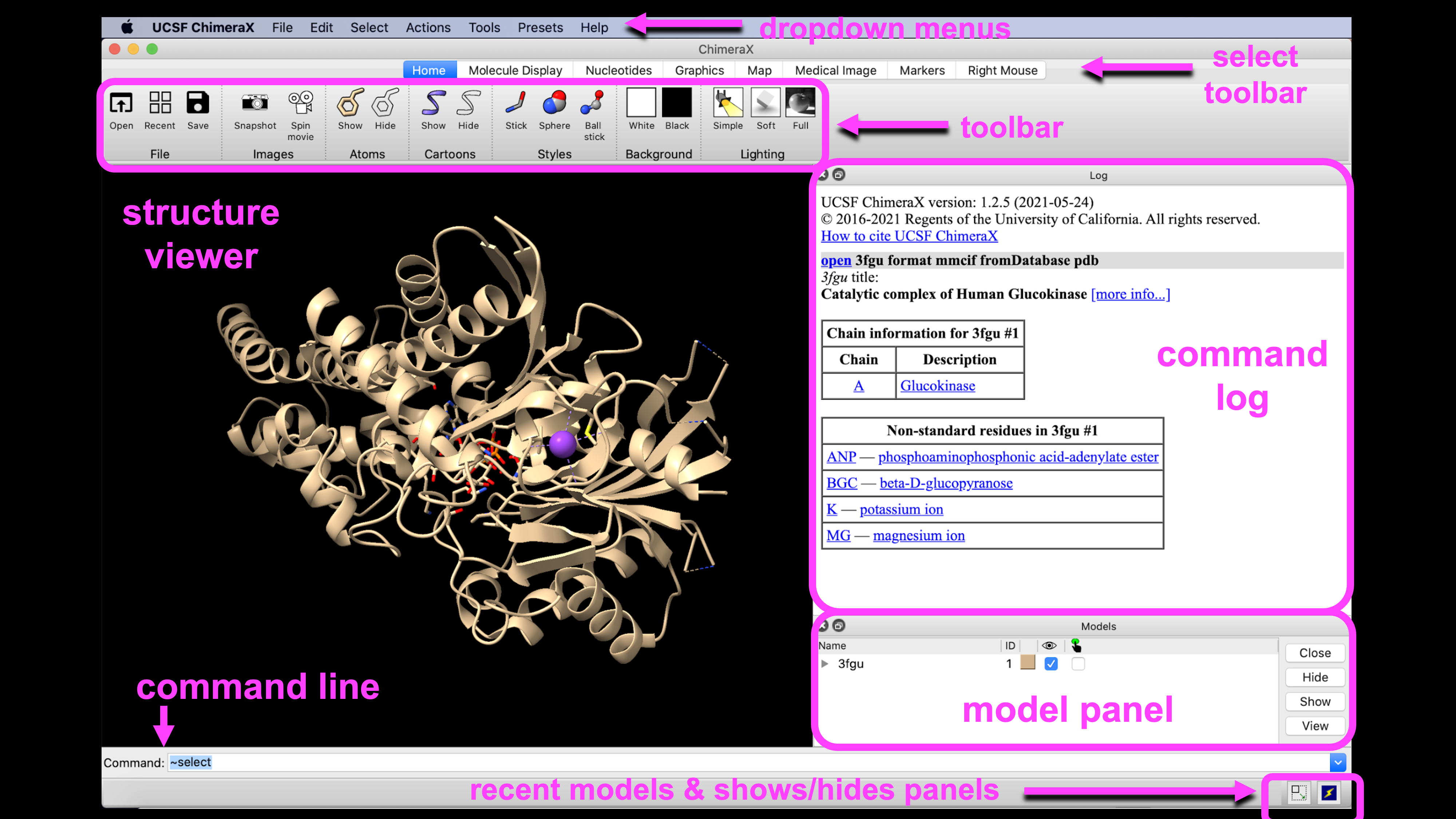I.A. Getting Started with ChimeraX
Walter Novak and Josh Beckham
Overview: This chapter presents the ChimeraX interface, guides the user to load a structure, and introduces trackpad and mouse controls.
Outcome: The user will be able to load a file in ChimeraX, perform basic manipulation (zoom, rotate, and center), save the file as a PNG image, and save all work (as a ChimeraX session).
Time to complete: 5–10 minutes
Modeling Skills
- Load a structure into the modeling program.
- Perform basic structure manipulation (e.g., zoom and rotate) with a trackpad or mouse.
About the Model
PDB ID: 3fgu
Protein: Catalytic complex of Human Glucokinase
Activity: One isoform of the enzyme that phosphorylates glucose in the first step of glycolysis
Description: single chain, with four bound ions and molecules. Potassium ion (K+) is from the crystallization medium and non-essential for biological function. Bound catalytic magnesium (Mg2+). Bound substrate: beta-D-glucose, and bound substrate analog phosphoaminophosphonic acid-adenylate ester (ANP). ANP is a non-hydrolyzable analog of ATP, thus this structure captures a similar view to the catalytic complex (enzyme-substrate complex).
The ChimeraX User Interface
Throughout these tutorials, we will refer to the following parts of the interface:

Steps
- Open ChimeraX by clicking on the application.
- In the command line, type: open 3FGU. The default render is ribbon (cartoon) with black background, small molecules shown as sticks, ions shown as spheres, and side chains of residue near the small molecules as sticks also.
Note: Structures can also be loaded through the dropdown menu:
File → Fetch by ID…
If it appears the dropdown menus are not present, ChimeraX may be viewable on your screen, but not selected. Click anywhere in the ChimeraX window to get your toolbars back.
- Now, familiarize yourself with basic structure manipulation using the guide below. Based on your specific trackpad or mouse, these may vary slightly. Play around to see how yours works.
- Rotate: Click and drag or use two-finger drag (mouse: left click and drag).
- Zoom: Pinch and spread (Mac) or Control + two-finger movement (PC) (mouse: scroll wheel).
- Translate: (i.e., Move the entire structure in one direction) Press Option + click and drag (Mac) or Shift + click and drag (PC) (mouse: right click and drag).
- Re-center: Use the dropdown menus at the top of the interface to click “Actions” → Focus.
- Position and zoom the structure as desired.
- (Optional) Save the file in two ways:
-
- Save a PNG image: Go to “File” → Save. Ensure the file type is set to “PNG image (*png).” Type a filename in the box and click “Save.”
- Save a ChimeraX session file: Go to “File” → Save. Select a directory. Ensure the file type is set to “ChimeraX session (*.CXS).” Type a filename in the box and click “Save.”
- Close the session by clicking the X in the corner, or use the dropdown menu: File → Close Session.
Jump to the next ChimeraX tutorial: II.A. ChimeraX Changing Color and Representation (Alternative Renderings).
